window FIAT SCUDO 2013 Owner handbook (in English)
[x] Cancel search | Manufacturer: FIAT, Model Year: 2013, Model line: SCUDO, Model: FIAT SCUDO 2013Pages: 223, PDF Size: 9.76 MB
Page 116 of 223
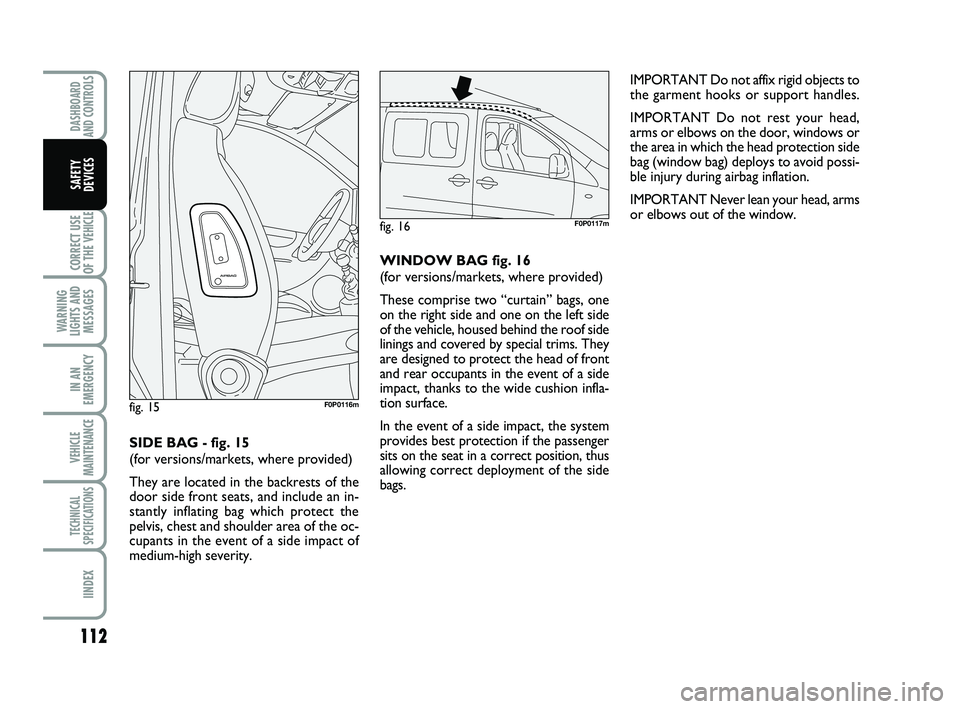
112
CORRECT USE
OF THE
VEHICLE
WARNING
LIGHTS AND
MESSAGES
IN AN
EMERGENCY
VEHICLE
MAINTENANCE
TECHNICAL
SPECIFICATIONS
IINDEX
DASHBOARD
AND CONTROLS
SAFETY
DEVICES
IMPORTANT Do not affix rigid objects to
the garment hooks or support handles.
IMPORTANT Do not rest your head,
arms or elbows on the door, windows or
the area in which the head protection side
bag (window bag) deploys to avoid possi-
ble injury during airbag inflation.
IMPORTANT Never lean your head, arms
or elbows out of the window.
WINDOW BAG fig. 16
(for versions/markets, where provided)
These comprise two “curtain” bags, one
on the right side and one on the left side
of the vehicle, housed behind the roof side
linings and covered by special trims. They
are designed to protect the head of front
and rear occupants in the event of a side
impact, thanks to the wide cushion infla-
tion surface.
In the event of a side impact, the system
provides best protection if the passenger
sits on the seat in a correct position, thus
allowing correct deployment of the side
bags.
fig. 16F0P0117m
fig. 15F0P0116m
SIDE BAG - fig. 15
(for versions/markets, where provided)
They are located in the backrests of the
door side front seats, and include an in-
stantly inflating bag which protect the
pelvis, chest and shoulder area of the oc-
cupants in the event of a side impact of
medium-high severity.
093-112 SCUDO LUM GB 9-10-2012 15:48 Pagina 112
Page 124 of 223

120
WARNING
LIGHTS AND
MESSAGES
IN AN
EMERGENCY
VEHICLE
MAINTENANCE
TECHNICAL
SPECIFICATIONS
INDEX
DASHBOARD
AND CONTROLS
SAFETY
DEVICES
CORRECT USE
OF THE VEHICLE
Roof rack/ski rack
Remove the roof rack or the ski rack from
the roof as soon as they are no longer
used. These accessories lower air pene-
tration and adversely affect consumption
levels. When needing to carry particular-
ly voluminous objects, preferably use a
trailer.
Electric devices
Use electric devices only for the amount
of time needed. Rear heated window, ad-
ditional headlights, windscreen wipers and
heater fan need a considerable amount of
energy, therefore increasing the require-
ment of current increases fuel consump-
tion (up to +25% in the urban cycle).
Climate control
The air conditioner is an additional load
which greatly affects the engine leading to
higher consumption (on average up to
+20%). When the temperature outside
the vehicle permits it, use the air vents
where possible.
Spoilers
The use of non-certified aerodynamic
items may adversely affect air drag and
consumption levels.DRIVING STYLE
Starting
Do not warm the engine when the vehi-
cle is stationary or at high or low speed:
in this way the engine will warm up grad-
ually increasing consumption and emis-
sions. You should drive off slowly straight
away avoiding high revs so that the engine
will warm up more quickly.
Unnecessary actions
Avoid accelerating when waiting at traffic
lights or before switching off the engine.
This and also double declutching is ab-
solutely pointless on modern vehicles and
also increase consumption and pollution.
Gear selections
As soon as the conditions of the traffic and
road allow, use a higher gear. Using a low
gear to obtain brilliant performance in-
creases consumption.
In the same way improper use of a high
gear increases consumption, emissions an
engine wear.CONTAINING
RUNNING COSTS
Some suggestions which may help you to
keep the running costs of the vehicle
down and lower the amount of toxic emis-
sions released into the atmosphere are
given below.
GENERAL CONSIDERATIONS
Vehicle maintenance
Carry out the checks and adjustments/reg-
ulations specified in the “Service Sched-
ule”.
Tyres
Check tyre inflation pressure regularly.
Tyres should be checked at least once
every four weeks: if the pressure is too
low, fuel consumption increases as the re-
sistance to the rolling movement of the
tyre is greater.
Unnecessary loads
Do not travel with too much load.
The weight of the vehicle (specially in ur-
ban traffic) and its trim greatly effects con-
sumption and stability.
115-124 SCUDO LUM GB_113-122 Nuovo ScudoG9 GB 17/10/12 14.41 Pagina 120
Page 128 of 223
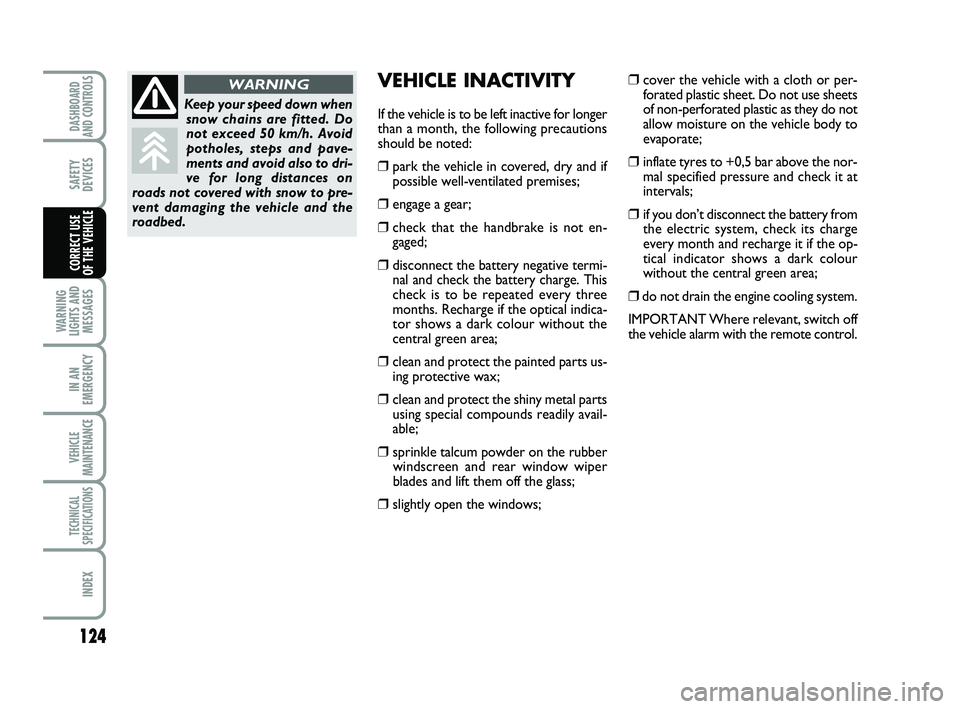
124
WARNING
LIGHTS AND
MESSAGES
IN AN
EMERGENCY
VEHICLE
MAINTENANCE
TECHNICAL
SPECIFICATIONS
INDEX
DASHBOARD
AND CONTROLS
SAFETY
DEVICES
CORRECT USE
OF THE VEHICLE
VEHICLE INACTIVITY
If the vehicle is to be left inactive for longer
than a month, the following precautions
should be noted:
❒park the vehicle in covered, dry and if
possible well-ventilated premises;
❒engage a gear;
❒check that the handbrake is not en-
gaged;
❒disconnect the battery negative termi-
nal and check the battery charge. This
check is to be repeated every three
months. Recharge if the optical indica-
tor shows a dark colour without the
central green area;
❒clean and protect the painted parts us-
ing protective wax;
❒clean and protect the shiny metal parts
using special compounds readily avail-
able;
❒ sprinkle talcum powder on the rubber
windscreen and rear window wiper
blades and lift them off the glass;
❒slightly open the windows;
❒cover the vehicle with a cloth or per-
forated plastic sheet. Do not use sheets
of non-perforated plastic as they do not
allow moisture on the vehicle body to
evaporate;
❒inflate tyres to +0,5 bar above the nor-
mal specified pressure and check it at
intervals;
❒if you don’t disconnect the battery from
the electric system, check its charge
every month and recharge it if the op-
tical indicator shows a dark colour
without the central green area;
❒do not drain the engine cooling system.
IMPORTANT Where relevant, switch off
the vehicle alarm with the remote control.
Keep your speed down when
snow chains are fitted. Do
not exceed 50 km/h. Avoid
potholes, steps and pave-
ments and avoid also to dri-
ve for long distances on
roads not covered with snow to pre-
vent damaging the vehicle and the
roadbed.
WARNING
115-124 SCUDO LUM GB_113-122 Nuovo ScudoG9 GB 17/10/12 14.41 Pagina 124
Page 153 of 223
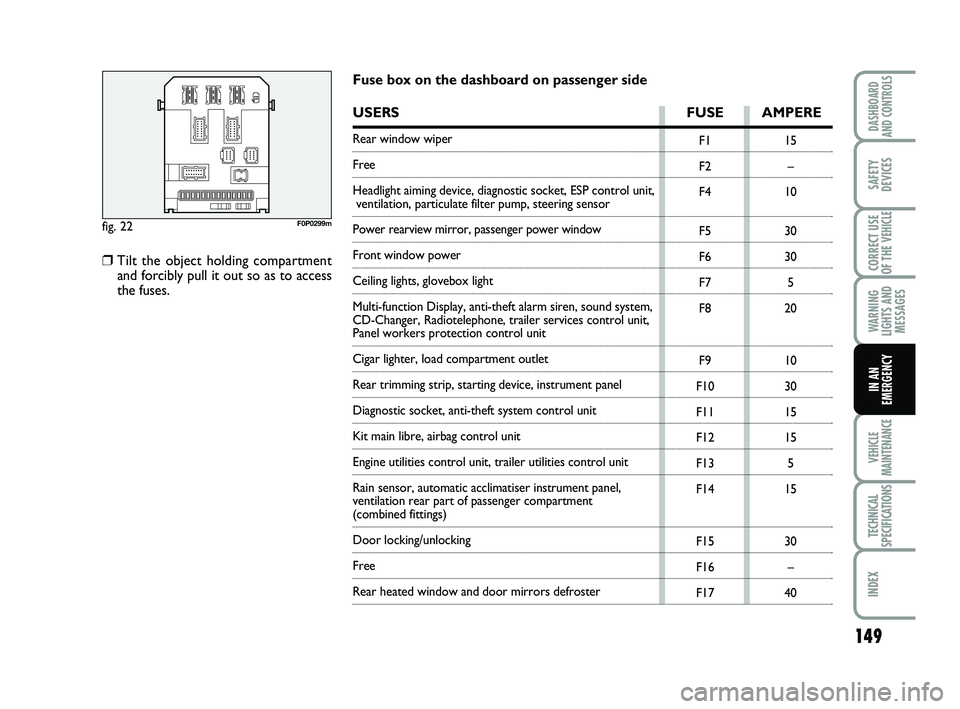
149
WARNING
LIGHTS AND
MESSAGES
VEHICLE
MAINTENANCE
TECHNICAL
SPECIFICATIONS
INDEX
DASHBOARD
AND CONTROLS
SAFETY
DEVICES
CORRECT USE
OF THE
VEHICLE
IN AN
EMERGENCY
fig. 22F0P0299m
F1
F2
F4
F5
F6
F7
F8
F9
F10
F11
F12
F13
F14
F15
F16
F1715
–
10
30
30
5
20
10
30
15
15
5
15
30
–
40
Fuse box on the dashboard on passenger side
USERS FUSE AMPERE
Rear window wiper
Free
Headlight aiming device, diagnostic socket, ESP control unit,
ventilation, particulate filter pump, steering sensor
Power rearview mirror, passenger power window
Front window power
Ceiling lights, glovebox light
Multi-function Display, anti-theft alarm siren, sound system,
CD-Changer, Radiotelephone, trailer services control unit,
Panel workers protection control unit
Cigar lighter, load compartment outlet
Rear trimming strip, starting device, instrument panel
Diagnostic socket, anti-theft system control unit
Kit main libre, airbag control unit
Engine utilities control unit, trailer utilities control unit
Rain sensor, automatic acclimatiser instrument panel,
ventilation rear part of passenger compartment
(combined fittings)
Door locking/unlocking
Free
Rear heated window and door mirrors defroster
❒Tilt the object holding compartment
and forcibly pull it out so as to access
the fuses.
135-154 SCUDO LUM GB_133-152 Nuovo ScudoG9 GB 17/10/12 14.43 Pagina 149
Page 154 of 223
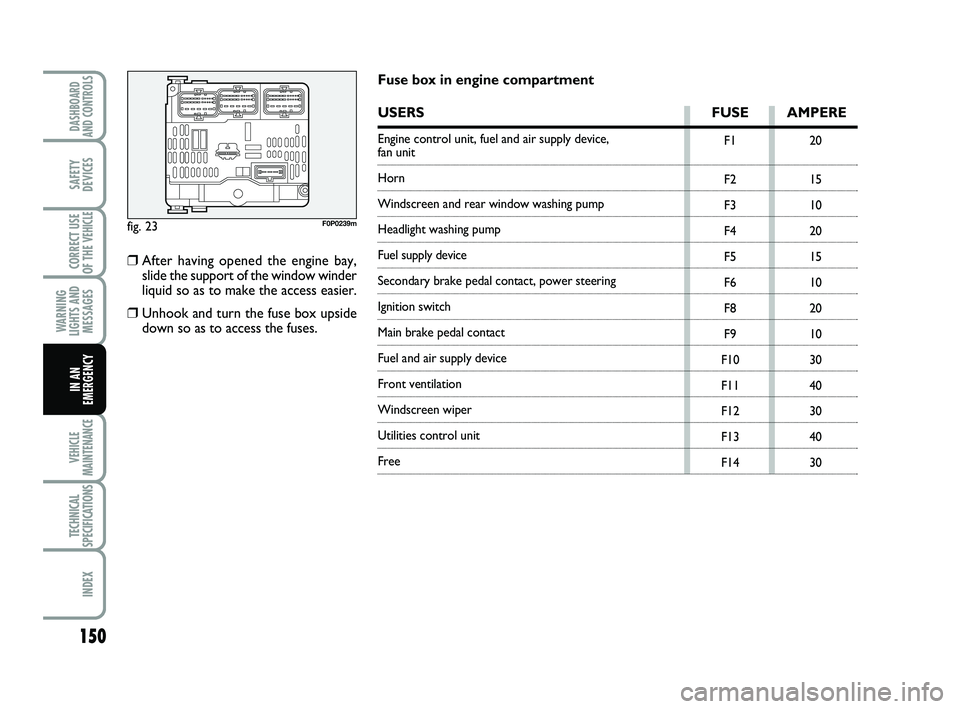
150
WARNING
LIGHTS AND
MESSAGES
VEHICLE
MAINTENANCE
TECHNICAL
SPECIFICATIONS
INDEX
DASHBOARD
AND CONTROLS
SAFETY
DEVICES
CORRECT USE
OF THE
VEHICLE
IN AN
EMERGENCY
fig. 23F0P0239m
F1
F2
F3
F4
F5
F6
F8
F9
F10
F11
F12
F13
F1420
15
10
20
15
10
20
10
30
40
30
40
30
Fuse box in engine compartment
USERS FUSE AMPERE
Engine control unit, fuel and air supply device, fan unit
Horn
Windscreen and rear window washing pump
Headlight washing pump
Fuel supply device
Secondary brake pedal contact, power steering
Ignition switch
Main brake pedal contact
Fuel and air supply device
Front ventilation
Windscreen wiper
Utilities control unit
Free
❒After having opened the engine bay,
slide the support of the window winder
liquid so as to make the access easier.
❒Unhook and turn the fuse box upside
down so as to access the fuses.
135-154 SCUDO LUM GB_133-152 Nuovo ScudoG9 GB 17/10/12 14.43 Pagina 150
Page 155 of 223

151
WARNING
LIGHTS AND
MESSAGES
VEHICLE
MAINTENANCE
TECHNICAL
SPECIFICATIONS
INDEX
DASHBOARD
AND CONTROLS
SAFETY
DEVICES
CORRECT USE
OF THE
VEHICLE
IN AN
EMERGENCY
fig. 24
F1
F2
F3
F1 F4 F3 F4 F5
F0P0241m
F1
F2
F3
F4
F36
F37
F38
F39
F4030
–
40/50
–
15
10
20
–
5
Fuse box in passenger compartment (on battery)
USERS FUSE AMPERE
Seat warming system
12V socket –third row seats (combined fittings)
Trailer services control unit and (for versions/markets,
where provided) Panel workers protection control unit
Free
Swing-door locks
Swing-door locks
Rear window wiper on swing-door
Ventilation rear part of passenger compartment
(combined fittings)
Folding mirrors
❒Unhook the cover of the battery com-
partment.
❒Remove the terminal of the red battery
(+).
After every operation, carefully close
the cover.
135-154 SCUDO LUM GB_133-152 Nuovo ScudoG9 GB 17/10/12 14.43 Pagina 151
Page 157 of 223
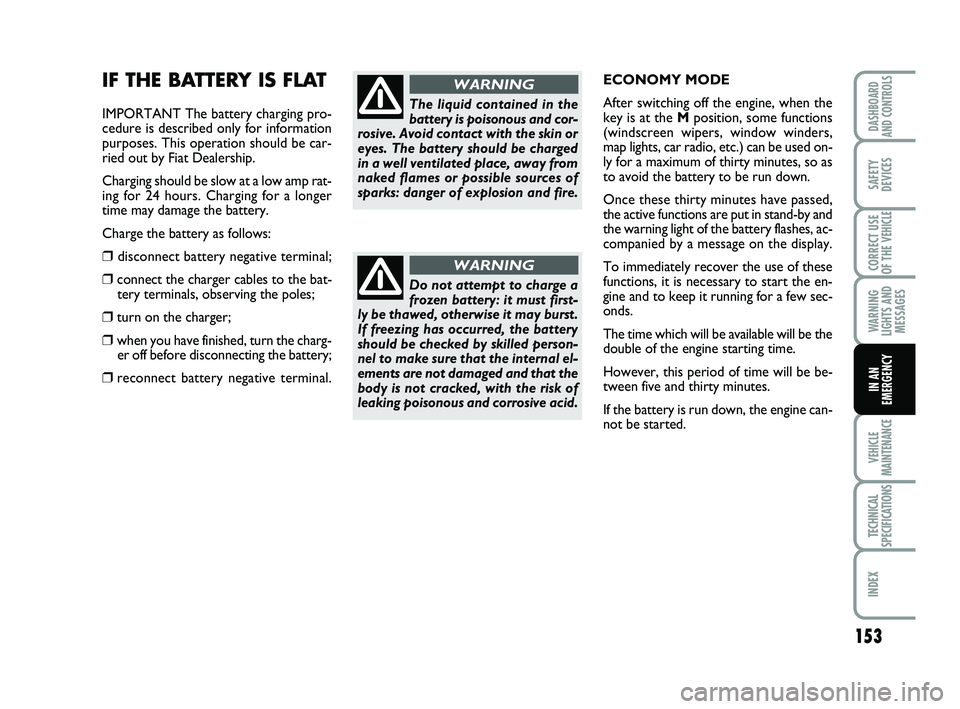
153
WARNING
LIGHTS AND
MESSAGES
VEHICLE
MAINTENANCE
TECHNICAL
SPECIFICATIONS
INDEX
DASHBOARD
AND CONTROLS
SAFETY
DEVICES
CORRECT USE
OF THE
VEHICLE
IN AN
EMERGENCY
IF THE BATTERY IS FLAT
IMPORTANT The battery charging pro-
cedure is described only for information
purposes. This operation should be car-
ried out by Fiat Dealership.
Charging should be slow at a low amp rat-
ing for 24 hours. Charging for a longer
time may damage the battery.
Charge the battery as follows:
❒disconnect battery negative terminal;
❒connect the charger cables to the bat-
tery terminals, observing the poles;
❒turn on the charger;
❒when you have finished, turn the charg-
er off before disconnecting the battery;
❒reconnect battery negative terminal.
The liquid contained in the
battery is poisonous and cor-
rosive. Avoid contact with the skin or
eyes. The battery should be charged
in a well ventilated place, away from
naked flames or possible sources of
sparks: danger of explosion and fire.
WARNING
Do not attempt to charge a
frozen battery: it must first-
ly be thawed, otherwise it may burst.
If freezing has occurred, the battery
should be checked by skilled person-
nel to make sure that the internal el-
ements are not damaged and that the
body is not cracked, with the risk of
leaking poisonous and corrosive acid.
WARNING
ECONOMY MODE
After switching off the engine, when the
key is at the Mposition, some functions
(windscreen wipers, window winders,
map lights, car radio, etc.) can be used on-
ly for a maximum of thirty minutes, so as
to avoid the battery to be run down.
Once these thirty minutes have passed,
the active functions are put in stand-by and
the warning light of the battery flashes, ac-
companied by a message on the display.
To immediately recover the use of these
functions, it is necessary to start the en-
gine and to keep it running for a few sec-
onds.
The time which will be available will be the
double of the engine starting time.
However, this period of time will be be-
tween five and thirty minutes.
If the battery is run down, the engine can-
not be started.
135-154 SCUDO LUM GB_133-152 Nuovo ScudoG9 GB 17/10/12 14.43 Pagina 153
Page 159 of 223
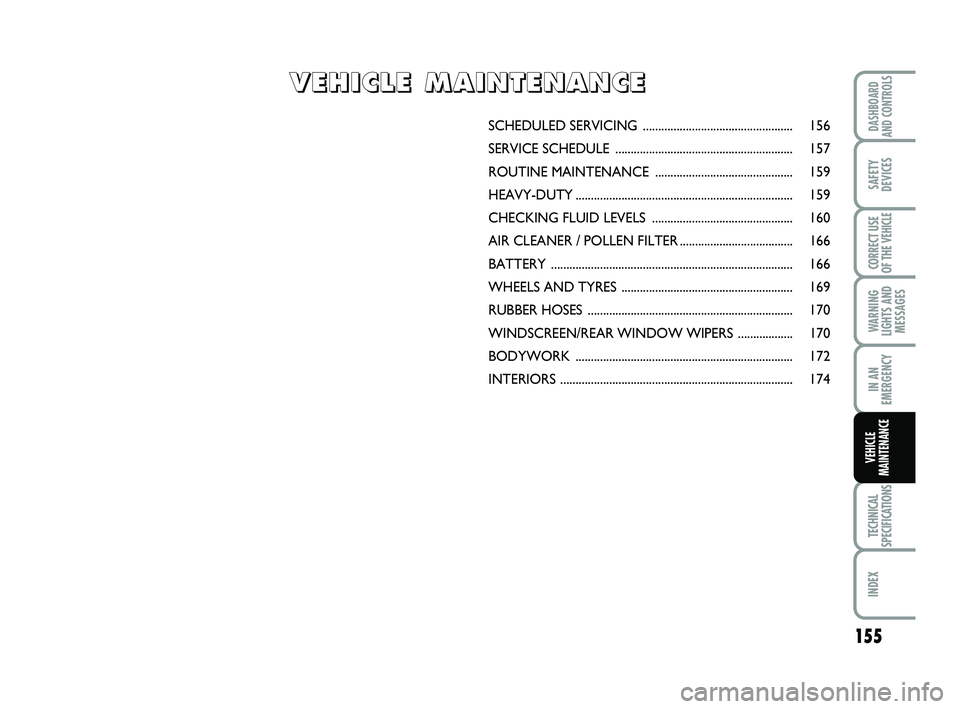
155
WARNING LIGHTS ANDMESSAGES
TECHNICAL SPECIFICATIONS
INDEX
DASHBOARD AND CONTROLS
SAFETY DEVICES
CORRECT USE OF THE
VEHICLE
IN AN EMERGENCY
VEHICLEMAINTENANCE
SCHEDULED SERVI CING ................................................. 156
SERVICE SCH EDULE .......................................................... 157
ROUTINE MAI NTENANCE ............................................. 159
HEAVY-D UTY ....................................................................... 159
CHECKING FLUID LEVELS .............................................. 160
AIR CLEANER / POLLEN FILTER .....................................166
BATTERY ............................................................................... 166
WHEELS AND TYRES ........................................................ 169
RUBBER HO SES ................................................................... 170
WINDSCREEN/REAR WINDOW WIPERS ..................170
BODYWORK ....................................................................... 172
INTERIO RS ............................................................................17
V V E E H H I I C C L L E E M M A A I I N N T T E E N N A A N N C C E E
155-174 SCUDO LUM GB_153-172 Nuovo ScudoG9 GB 17/10/12 14.44 Pagina 155
4
Page 161 of 223
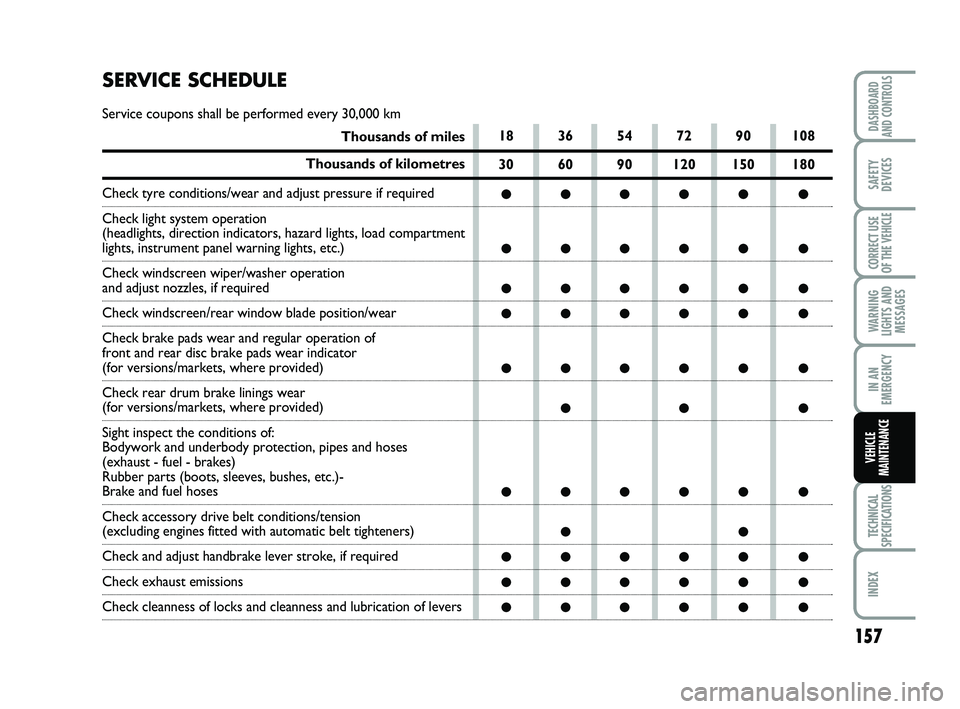
157
WARNING
LIGHTS AND
MESSAGES
TECHNICAL
SPECIFICATIONS
INDEX
DASHBOARD
AND CONTROLS
SAFETY
DEVICES
CORRECT USE
OF THE
VEHICLE
IN AN
EMERGENCY
VEHICLE
MAINTENANCE
18 36 54 72 90 108
30 60 90 120 150 180
●●●●● ●
●●●●● ●
●●●●● ●
●●●●● ●
●●●●● ●
●● ●
●●●●● ●
●●
●●●●● ●
●●●●● ●
●●●●● ●
SERVICE SCHEDULE
Service coupons shall be performed every 30,000 km
Thousands of miles
Thousands of kilometres
Check tyre conditions/wear and adjust pressure if required
Check light system operation
(headlights, direction indicators, hazard lights, load compartment
lights, instrument panel warning lights, etc.)
Check windscreen wiper/washer operation
and adjust nozzles, if required
Check windscreen/rear window blade position/wear
Check brake pads wear and regular operation of
front and rear disc brake pads wear indicator
(for versions/markets, where provided)
Check rear drum brake linings wear
(for versions/markets, where provided)
Sight inspect the conditions of:
Bodywork and underbody protection, pipes and hoses
(exhaust - fuel - brakes)
Rubber parts (boots, sleeves, bushes, etc.)-
Brake and fuel hoses
Check accessory drive belt conditions/tension
(excluding engines fitted with automatic belt tighteners)
Check and adjust handbrake lever stroke, if required
Check exhaust emissions
Check cleanness of locks and cleanness and lubrication of levers
155-174 SCUDO LUM GB_153-172 Nuovo ScudoG9 GB 17/10/12 14.44 Pagina 157
Page 163 of 223
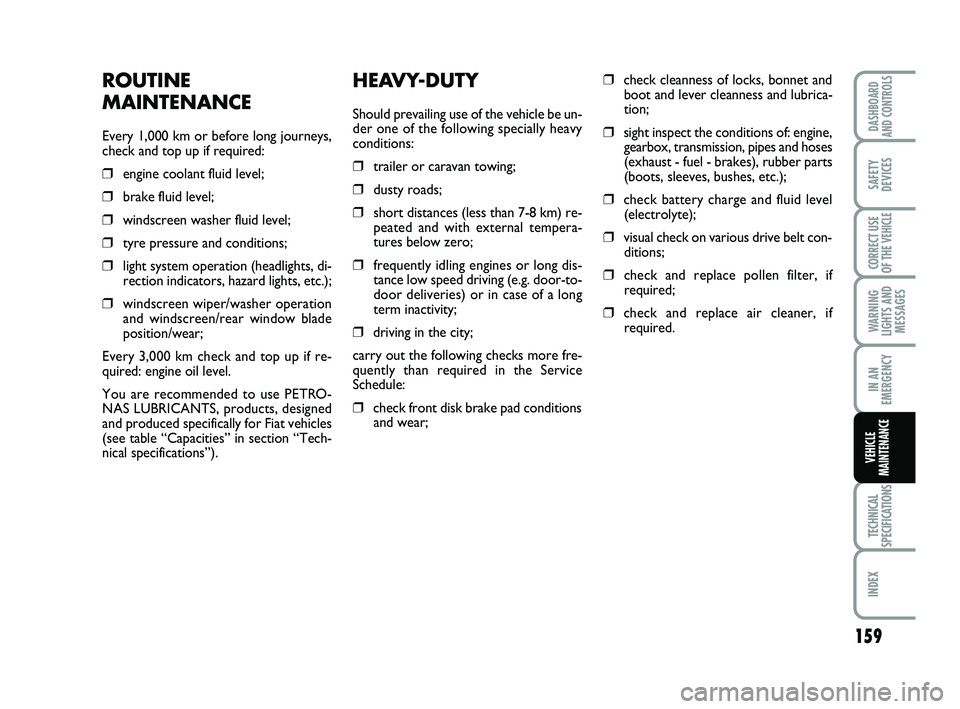
159
WARNING
LIGHTS AND
MESSAGES
TECHNICAL
SPECIFICATIONS
INDEX
DASHBOARD
AND CONTROLS
SAFETY
DEVICES
CORRECT USE
OF THE
VEHICLE
IN AN
EMERGENCY
VEHICLE
MAINTENANCE
HEAVY-DUTY
Should prevailing use of the vehicle be un-
der one of the following specially heavy
conditions:
❒trailer or caravan towing;
❒dusty roads;
❒short distances (less than 7-8 km) re-
peated and with external tempera-
tures below zero;
❒frequently idling engines or long dis-
tance low speed driving (e.g. door-to-
door deliveries) or in case of a long
term inactivity;
❒driving in the city;
carry out the following checks more fre-
quently than required in the Service
Schedule:
❒check front disk brake pad conditions
and wear;
❒check cleanness of locks, bonnet and
boot and lever cleanness and lubrica-
tion;
❒sight inspect the conditions of: engine,
gearbox, transmission, pipes and hoses
(exhaust - fuel - brakes), rubber parts
(boots, sleeves, bushes, etc.);
❒check battery charge and fluid level
(electrolyte);
❒visual check on various drive belt con-
ditions;
❒check and replace pollen filter, if
required;
❒check and replace air cleaner, if
required.
ROUTINE
MAINTENANCE
Every 1,000 km or before long journeys,
check and top up if required:
❒engine coolant fluid level;
❒brake fluid level;
❒windscreen washer fluid level;
❒tyre pressure and conditions;
❒light system operation (headlights, di-
rection indicators, hazard lights, etc.);
❒windscreen wiper/washer operation
and windscreen/rear window blade
position/wear;
Every 3,000 km check and top up if re-
quired: engine oil level.
You are recommended to use PETRO-
NAS LUBRICANTS, products, designed
and produced specifically for Fiat vehicles
(see table “Capacities” in section “Tech-
nical specifications”).
155-174 SCUDO LUM GB_153-172 Nuovo ScudoG9 GB 17/10/12 14.44 Pagina 159